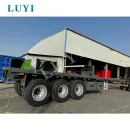How to Choose a Flatbed Semi Trailer ?
Oct. 17, 2024
Determine Your Cargo Needs
Before selecting a flatbed semi trailer, it’s crucial to assess what kind of cargo you'll be transporting. Flatbeds are versatile and can handle anything from machinery to building materials, but each cargo type may require specific trailer features. For example, heavy loads might need a reinforced structure, while oversized items could benefit from a wider trailer. Understanding the weight and dimensions of your cargo will help you determine the appropriate size, axle configuration, and material strength.
Consider Trailer Dimensions
Flatbed trailers come in various lengths and widths, typically ranging from 40 to 53 feet in length and 8.5 feet in width. The specific dimensions of the trailer should align with both the cargo size and the regulations in the areas where you plan to operate. Oversized loads may require permits, and different states or countries may have restrictions on trailer dimensions. Additionally, ensure that the trailer height is appropriate for your loading and unloading facilities.
Material Construction
The material used in the construction of a flatbed semi trailer affects both its durability and weight capacity. Steel trailers are incredibly durable and can handle heavy loads but are also heavier, which could impact fuel efficiency. Aluminum trailers, on the other hand, are lighter and more resistant to corrosion, making them ideal for lighter loads and long-term cost savings. Some trailers are made of a combination of both materials to provide a balance between strength and weight.

Axle Configuration
The number of axles on a flatbed trailer determines how much weight it can carry. For heavier loads, a trailer with more axles may be necessary to distribute the weight more evenly and comply with legal weight limits. Single-axle, tandem-axle, and tri-axle configurations each have their advantages depending on the cargo and road conditions. The right choice will help maintain stability, improve handling, and reduce wear on the trailer and tires.
Load Securing Features
Ensuring that cargo is safely secured is one of the most important aspects of flatbed transportation. Look for trailers that have sufficient tie-down points, winches, and other securing systems to handle your specific loads. Some flatbeds are equipped with built-in straps or chains, while others may require additional securing tools. Ensuring your trailer has the right load-securing capabilities can prevent accidents and improve safety during transportation.
Related articles:Transportation
Maintenance and Durability
Maintaining a flatbed semi trailer is essential for its longevity and safety. Look for trailers that are easy to inspect and maintain, particularly those with accessible brake systems, lights, and tires. Additionally, consider the durability of the material and construction, especially if you operate in harsh weather conditions or on rough terrain. A well-built trailer will require less frequent maintenance and offer a longer lifespan, reducing overall ownership costs.
Trailer Weight and Fuel Efficiency
Fuel efficiency is a key consideration, especially for long-haul operations. Lighter trailers, often made of aluminum, can improve fuel efficiency, which is a critical factor for businesses looking to reduce operational costs. Heavier steel trailers may be better suited for short-distance, high-weight operations, but keep in mind the trade-off between weight capacity and fuel consumption. Choosing the right balance between weight and strength can lead to significant cost savings over time.
Regulatory Compliance
Each region has specific regulations for trailer size, weight, and safety features. Ensure the flatbed semi trailer you choose complies with the local and international standards for the areas you’ll be operating in. Failure to comply with these regulations can result in fines, delays, and costly modifications. Working with a manufacturer who understands these regulations will help ensure your trailer meets all legal requirements from the start.
Price vs. Value
While it’s tempting to go for the cheapest option, it’s important to balance cost with value. Consider the trailer's durability, material quality, and features in relation to its price. A cheaper trailer may save money initially but could result in higher maintenance costs or shorter lifespan. On the other hand, a higher upfront investment in a quality trailer may offer better long-term value through lower maintenance costs and longer service life.
Warranty and Support
Finally, look for a flatbed semi trailer manufacturer that offers a solid warranty and after-sales support. A good warranty will cover potential defects and provide peace of mind, while reliable customer service ensures you can get assistance if any issues arise. Some manufacturers offer extended warranties, roadside assistance, or maintenance packages, which can further reduce downtime and protect your investment.
Conclusion
Choosing the right flatbed semi trailer requires careful consideration of your cargo needs, trailer dimensions, material construction, and regulatory requirements. By evaluating these factors, you can select a trailer that not only meets your operational needs but also offers long-term reliability and value. Partnering with a trusted manufacturer will ensure you receive a high-quality product backed by strong customer support and warranties.
374
0
0
None
None


Comments
All Comments (0)